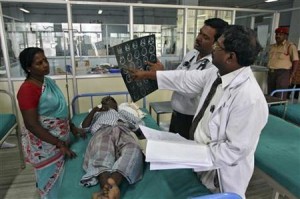 According to a recent report by Deloitte, India’s public health care system is patchy, with underfunded and overcrowded hospitals and clinics, and inadequate rural coverage. Reduced funding by the Indian Government has been attributed to historic failures on the part of the Ministry of Health and Family Welfare (MHFW) to spend its allocated budget fully. According to the World Health Organization (WHO), just 33 percent of Indian health care expenditures in 2012 came from government sources.
According to a recent report by Deloitte, India’s public health care system is patchy, with underfunded and overcrowded hospitals and clinics, and inadequate rural coverage. Reduced funding by the Indian Government has been attributed to historic failures on the part of the Ministry of Health and Family Welfare (MHFW) to spend its allocated budget fully. According to the World Health Organization (WHO), just 33 percent of Indian health care expenditures in 2012 came from government sources.
And, today, challenges remain. The vision for the plan period of 2012-2017 is to achieve acceptable standards of health care for the Indian populace. However, India still doesn’t have a central regulatory authority for its health care sector. Additionally, India’s health care sector is capital-intensive, with long gestation and payback periods of new projects. Land and infrastructure costs account for 60-70 percent of capital expenditure for hospitals. Further, the industry also requires capital for upgrade/maintenance/replacement of medical equipment and expansion. Availability of capital at a reasonable cost remains a hurdle.
One way to increase India’s health care funding and access is through innovative public-private partnerships. Among other suggestions to improve care, companies should leverage information technology (IT) to create patient-centric healthcare systems that can improve response times, reduce human error, save costs, and impact the quality of life. At the same time, the government should focus on establishing more medical colleges and training institutes to provide the requisite doctors, dentists, nurses and paramedics. The government should also invest in preventive and social medicine by promoting health education and preventive health-care concepts.
